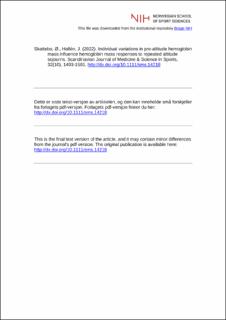| dc.contributor.author | Skattebo, Øyvind | |
| dc.contributor.author | Hallén, Jostein | |
| dc.date.accessioned | 2023-08-10T10:55:41Z | |
| dc.date.available | 2023-08-10T10:55:41Z | |
| dc.date.created | 2022-09-13T18:16:21Z | |
| dc.date.issued | 2022 | |
| dc.identifier.citation | Scandinavian Journal of Medicine & Science in Sports. 2022, 32(10), 1493-1501. | en_US |
| dc.identifier.issn | 0905-7188 | |
| dc.identifier.uri | https://hdl.handle.net/11250/3083345 | |
| dc.description | I Brage finner du siste tekst-versjon av artikkelen, og den kan inneholde ubetydelige forskjeller fra forlagets pdf-versjon. Forlagets pdf-versjon finner du på humankinetics.com / In Brage you'll find the final text version of the article, and it may contain insignificant differences from the journal's pdf version. The original publication is available at humankinetics.com | en_US |
| dc.description.abstract | Introduction: Previous studies have shown variable within-subject hemoglobin mass (Hbmass) responses to altitude training. We investigated whether Hbmass responses depend on individual variations in pre-altitude Hbmass during repeated altitude sojourns. Methods: Nine elite endurance athletes carried out 3–5 altitude sojourns over 17 ± 10 months (mean ± 95% confidence interval), at an altitude of 1976 ± 62 m, for 21 ± 1 days, and a total hypoxic dose of 989 ± 46 km·h, with Hbmass assessed before and after each sojourn (carbon monoxide rebreathing). The individual mean baseline was calculated as the mean of all pre-altitude Hbmass values for an athlete, and it was investigated whether the percent deviation from the individual mean baseline affected the altitude-induced Hbmass response. Results: On average, Hbmass increased by 3.4 ± 1.1% (p < 0.001) from pre- to post-altitude. The intra-individual changes in Hbmass were highly inconsistent (coefficient of variation, CV: 88%), and we found no relationship between Hbmass changes in successive altitude sojourns (r = 0.01; p = 0.735). However, the percent increase in Hbmass was highly correlated with the pre-altitude Hbmass, expressed as the percent deviation from the individual mean baseline (y = −0.7x + 3.4; r = 0.75; p < 0.001). Linear mixed-model analysis confirmed a −0.6 ± 0.2% smaller increase in Hbmass for each 1% higher pre-altitude Hbmass than the individual mean baseline (p < 0.001) after adjusting for the covariates hypoxic dose (p = 0.032) and the relative Hbmass (g·kg−1 body weight; p = 0.031). Conclusion: Individual variations in pre-altitude Hbmass significantly influence the athletes' Hbmass responses to repeated altitude sojourns, with a potentiated response after traveling to altitude with a low pre-altitude Hbmass. | en_US |
| dc.language.iso | eng | en_US |
| dc.subject | altitude training | en_US |
| dc.subject | blood volume | en_US |
| dc.subject | endurance athletes | en_US |
| dc.subject | erythropoiesis | en_US |
| dc.subject | hemoglobin mass | en_US |
| dc.subject | hypoxia | en_US |
| dc.subject | individual response | en_US |
| dc.subject | maximal oxygen uptake | en_US |
| dc.title | Individual variations in pre-altitude hemoglobin mass influence hemoglobin mass responses to repeated altitude sojourns | en_US |
| dc.title.alternative | Individual variations in pre-altitude hemoglobin mass influence hemoglobin mass responses to repeated altitude sojourns | en_US |
| dc.type | Peer reviewed | en_US |
| dc.type | Journal article | en_US |
| dc.description.version | acceptedVersion | en_US |
| dc.source.pagenumber | 1493-1501 | en_US |
| dc.source.volume | 32 | en_US |
| dc.source.journal | Scandinavian Journal of Medicine & Science in Sports | en_US |
| dc.source.issue | 10 | en_US |
| dc.identifier.doi | 10.1111/sms.14218 | |
| dc.identifier.cristin | 2051398 | |
| dc.description.localcode | Institutt for fysisk prestasjonsevne / Department of Physical Performance | en_US |
| cristin.ispublished | true | |
| cristin.fulltext | postprint | |
| cristin.qualitycode | 1 | |
